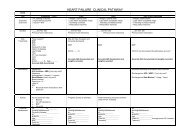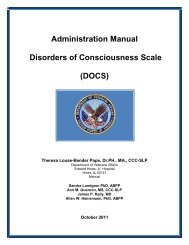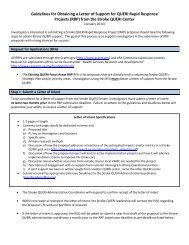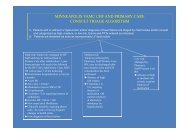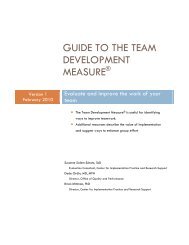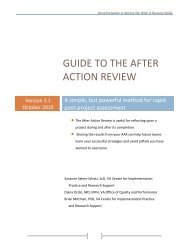The Veteran Supported Education Service Treatment Manual: VetSEd
The Veteran Supported Education Service Treatment Manual: VetSEd
The Veteran Supported Education Service Treatment Manual: VetSEd
Create successful ePaper yourself
Turn your PDF publications into a flip-book with our unique Google optimized e-Paper software.
V. BUILDING A SUPPORTED EDUCATION REFERRAL POOL FOR <strong>VetSEd</strong><br />
Unlike supported employment, the eligibility criteria above do not specify that referrals<br />
to the <strong>VetSEd</strong> program come solely from VA Medical Centers. Hence, strategies for<br />
outreach and for building a referral pool are indicated. One of these will be sharing<br />
information about supported education to develop a large base of referral sources.<br />
Developing relationships with other <strong>Veteran</strong> programs and school services will increase<br />
sources of referrals. Referrals can be sought through case management and treatment<br />
team meetings, <strong>Veteran</strong> related activities, and periodic information sessions for internal<br />
or external groups. An effective supported education referral process has minimal barriers<br />
to entry. You will increase the number of referrals received if you educate key<br />
stakeholders about the role that education can play in recovery from mental health,<br />
substance abuse and trauma related problems, tell them about the availability of<br />
supported education services, and make it easy to refer <strong>Veteran</strong>s to your program.<br />
Establishing connections within the <strong>Veteran</strong> system that maintain a consistent flow of<br />
referrals for your education program is crucial for ongoing success. <strong>Education</strong>al providers<br />
need to inform clinical treatment team members about the program and then<br />
communicate the steps to enroll in the program. Communicating the minimal eligibility<br />
criteria to referral sources is also an initial step. Simple referral forms and easy methods<br />
of communication among education providers and referral sources are essential in the<br />
process. Overall, developing a user-friendly referral process will assist in maintaining a<br />
viable program.<br />
Strategies for Increasing <strong>Supported</strong> <strong>Education</strong> Referrals into <strong>VetSEd</strong><br />
(adapted from Becker & Drake, 2003)<br />
Inform key stakeholders about the opportunities and enlist their support in the<br />
referral process<br />
Talk to <strong>Veteran</strong>s and groups<br />
Talk to <strong>Veteran</strong>s who may be interested in work<br />
Speak at local community meetings<br />
Speak at local <strong>Veteran</strong> organizations to educate <strong>Veteran</strong>s about work and<br />
<strong>VetSEd</strong><br />
Present at local, state, and national conferences (e.g., National Alliance on<br />
Mental Illness)<br />
153 | P a g e



